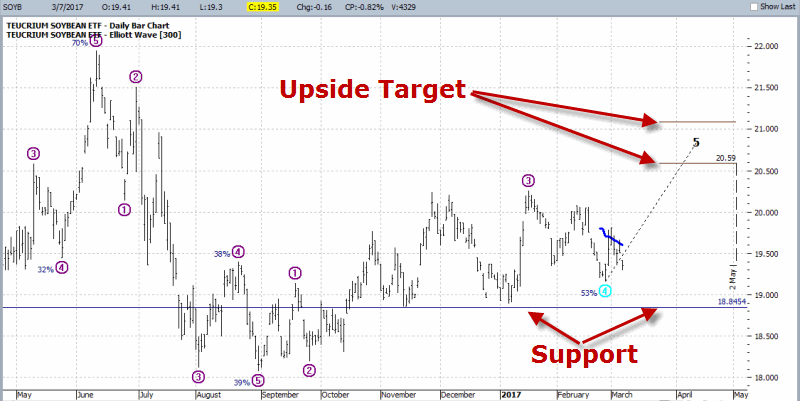There are a lot of “interesting” things going on in the markets these days. Granted, alot of people may think of the words “soybeans”, “t-bonds” and “british pounds” and then think “that word – interesting – I do not think it means what you think it means.” But hey, for us market geeks they can be some of the most “exciting” words around.
So let’s take a look.
(See also The 40-Week Cycle Recycles)
Soybeans
As I wrote about here, soybeans have long showed a propensity to rally during late winter into spring. Figure 1 displays the annual seasonal trend for soybean futures. It is important to note that this is a historical representation of what has happended in the past and is NOT a roadmap for what will happen this time around.

Figure 1 – Soybeans Annual Seasonal Trend
Figure 2 displays ticker Teucrium Soybean (NYSE:SOYB)– an ETF that tracks soybean futures. As you can see the Elliott Wave count is projecting a Wave 5 up. The upside target is the projected range of $20.59 to $21.09 a share. Support can be found at the recent low near $18.85. Please note that there is no guarantee that the bullish seasonal tendency will “win the day” this time around. But the setup is in place – so it’s”soon or never” for beans this time around.
Figure 2 – Ticker SOYB (Courtesy ProfitSource by HUBB)
T-Bonds
In this article I wrote about the possibility for a decline in t-bonds and an example option trade. As you can see in Figure 3, bonds have declined since then and a price target projection of $112.78 a share remains intact
. 
Figure 3 – T-Bonds (ticker iShares 20+ Year Treasury Bond (NASDAQ:TLT)) “DOWN”….. (Courtesy ProfitSource by HUBB)

Figure 4 – ….April TLT bear put spread “UP”
British Pound
In this article I noted the tendency for the british pound to decline towards the 8th trading day of March – and then rally into mid-May. As with any seasonal trend, this is a “tendency” and not a “certainty”. Still, a glance at Figure 5 may suggest that a “multiple bottom” (as we technical analysis geek types like to say) or perhaps even an “inverse head-and-shoulders bottom” (as we technical analysis geeks who like to think we’re pretty sophisticated like to say).

Figure 5 – A potential head-and-shoulders bottom may be forming in Ticker Guggenheim CurrencyShares British Pound Sterling (NYSE:FXB) (ETF that track the british pound)
The annual seasonal trend chart in Figure 5 suggests a potential reversal of fortune from bearish to bullish as of the close on March Trading Day #8, which is Friday, March 10th.

Figure 5 – British Pound Annual Seasonal Trend
Summary
No one should assume that soybeans and the british pound are certain to rally soon, or that t-bonds are destined to trade lower from here. All that I have done here is to highlight trends and tendencies.
Identifying potential opportunities is only one part of the investing/trading equation. Determining “whether or not” to exploit a given potential opportunity, exactly “how” to exploit said opportunity and how to “manage the risk” associated with said opportunity are equally important.
So do not consider what I have written hear as “recommendations”. They are simply ideas that fit into the “spot opportunity” category. Nothing more, nothing less.
Disclaimer: The data presented herein were obtained from various third-party sources. While I believe the data to be reliable, no representation is made as to, and no responsibility, warranty or liability is accepted for the accuracy or completeness of such information. The information, opinions and ideas expressed herein are for informational and educational purposes only and do not constitute and should not be construed as investment advice, an advertisement or offering of investment advisory services, or an offer to sell or a solicitation to buy any security.

